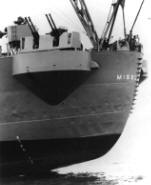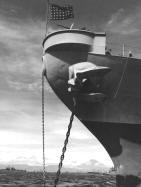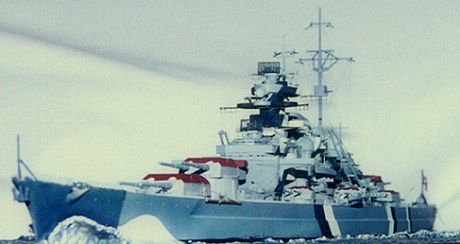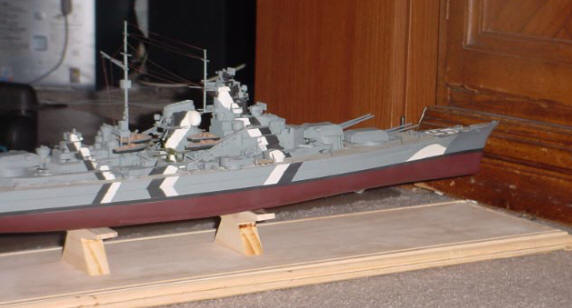After the success achieved by the surface ships in the
Atlantic waters during the winter of 1940-1941, the German Naval High Command
decided to launch a much more ambitious operation. The idea was to send to the
Atlantic a powerful battle group comprised by the battleships Bismarck,
Tirpitz, Scharnhorst and Gneisenau. These last two
battleships were in Brest, in the occupied France, since 22 March, after a
successful campaign of two months in the North Atlantic under the command of the
Fleet Chief, Admiral
Günther Lütjens, in which
they sank or captured 22 ships with a total tonnage of 116,000 tons. The
Bismarck which had almost finished her trials would soon be ready for her
first war mission. But her sister ship, the Tirpitz which had just been
commissioned on 25 February still had to spend some months of training, and it
was not probable that she would be ready for the spring. Moreover, the
Scharnhorst had to enter dry dock in order to do some repairs in her
machinery, and that would immobilize the ship at least until June.
On 2 April, the same day the Bismarck received
her last two
Arado 196, the High
Command outlined the strategy to follow in its operation order (B.Nr. 1. Skl. I
Op. 410/41 Gkdos Chefs.). With the Scharnhorst in dry dock and the
Tirpitz not ready for action yet, the Bismarck and the heavy cruiser
Prinz Eugen would be sent to the North Atlantic at the end of April under
the command of the Fleet Chief. These two ships would be joined later by the
Gneisenau sailing from Brest. The task of the German ships was to attack the
convoys operating in the North Atlantic over the Equatorial line. Nevertheless,
after the experience got with the Scharnhorst and the Gneisenau in
the last months, now the enemy convoys were strongly protected by British
cruisers or battleships. So if that was the case, the powerful Bismarck
would take care of the escorting ship thus allowing the other ships to attack
the convoy without any problem.
The British Admiralty was worried and suspected that
the Germans were planning a big operation with surface ships in the Atlantic.
The British knew about the presence of the Scharnhorst and the
Gneisenau in Brest and the danger that would represent their sortie to the
sea. Therefore they made arrangements to immobilize the German battleships
through air bombings. On 6 April, a Coastal Command Beaufort plane (Lieutenant
Kenneth Campbell) of the 22º Squadron scored a torpedo hit on Gneisenau's
stern. The British aircraft was shot down by the anti-aircraft batteries, but
the Gneisenau was damaged and had to enter dry dock for repairs. A few
days later, during the night of 10/11 April, the battleship was hit again. This
time by four bombs during a bombing by the RAF, and this forced to lengthen the
repair work during months. Therefore, only the Bismarck and the Prinz
Eugen would be ready to sail and attack enemy merchant shipping in the
spring.
So it seems that there were more than enough reasons to
cancel Bismarck's departure and wait until the autumn for the Tirpitz
or the battleships stationed in Brest to be ready. Also the short spring nights
increased the possibility to detect the German ships before they could get into
the Atlantic. Nevertheless, the idea to send the Bismarck and the
Prinz Eugen to the Atlantic in the spring of 1941 was not bad at all. The
United Kingdom was in a critical situation and five months of "relative calm" at
sea would have only strengthened her position. We also have to take in
consideration that this could be the last opportunity for German ships to reach
the Atlantic and have some freedom of movement, since the war with the United
States would have to come some day and then this task would be much more
difficult if not impossible. It was also ironic maintain a ship with the
potential of the Bismarck in her home base doing nothing. Grand Admiral
Erich Raeder wanted to maintain the pressure on the British and decided to go on
with the operation. The most important thing was that the two German ships could
reach the Atlantic unnoticed. Then they could get lost in the immensity of the
ocean and attack the enemy convoys.
Meanwhile, on 8 April, Admiral Lütjens had met the
U-boat Chief, Vice-Admiral Karl Dönitz in Paris. Both Admirals knew each other
well as they had coincided in several occasions before the war. At the
conference they outlined the support that was to be given to the Bismarck
by the U-boats. The U-boats would carry on as usual in their normal positions,
but if any opportunity arose for a combined action with U-boats they should
exploit it to the full. A U-boat officer was therefore assigned to the
Bismarck.
On 22 April, Admiral Lütjens established the details of
the operation now code named Rheinübung (Rhine Exercise). The departure
of the German ships was imminent, but on 23 April, a magnetic mine exploded near
the Prinz Eugen while on her way to Kiel, and because of the repair work
the operation was delayed for some days. Three days later, on 26 April, Lütjens
and Raeder met in Berlin to examine the situation. The Fleet Chief suggested
Raeder the possibility to postpone the operation but finally agreed with the
Grand Admiral's intentions to resume the battle of the Atlantic as soon as
possible. On 5 May, Hitler visited Gotenhafen to inspect the Bismarck and
the Tirpitz. Raeder was absent, and Lütjens received the Führer,
but he didn't inform him about the next sortie of his ships. The departure of
the Bismarck was again delayed on 14 May, this time because her port
crane had to be repaired and therefore a couple of days more were lost. Finally
on 16 May, Lütjens informed the High Command that the ships were ready, and the
date for the beginning of Operation Rheinübung was established for 18
May.





